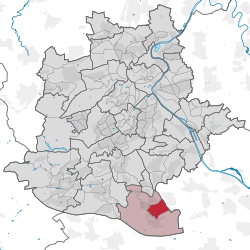Hohenheim
| Stuttgart-Hohenheim | ||
|---|---|---|
| Quarter of Stuttgart | ||

|
||
|
||
|
Location within Plieningen, Stuttgart
|
||
| Coordinates: 48°42′42.48″N 9°12′40.68″E / 48.7118000°N 9.2113000°ECoordinates: 48°42′42.48″N 9°12′40.68″E / 48.7118000°N 9.2113000°E | ||
| Country | Germany | |
| State | Baden-Württemberg | |
| Admin. region | Stuttgart (region) | |
| District | Stuttgart | |
| City | Stuttgart | |
| Borough | Plieningen | |
| Founded | 1782 | |
| Area | ||
| • Quarter of Stuttgart | 1,563 km2 (603 sq mi) | |
| Population (2011) | ||
| • Metro | 575 | |
| Time zone | CET/CEST (UTC+1/+2) | |
| Postal codes | 70599 | |
| Dialling codes | 0711 | |
Hohenheim (pronunciation: /hoʊnhaɪm/) is one of 18 outer districts of the city of Stuttgart in the borough of Plieningen that sits on the Filder in central Baden-Württemberg. The Municipality was founded in 1782.
Hohenheim sits on the Filder, a large and fertile plateau in the center of Baden-Württemberg. Hohenheim forms the Plieningen Municipality of Stuttgart along with Asemwald, Chausseefeld, Plieningen and Steckfeld.
The district was founded in 1782 when Schloss Hohenheim was constructed on the orders of Charles Eugene of Baden-Württemberg. The University of Hohenheim, as the name might imply, is based here and uses much of Schloss Hohenheim for its campus.
Stuttgart-Hohenheim (also known simply as Hohenheim) is a quarter of Plieningen, one of the 18 outer districts of Stuttgart, the state capital of Baden-Württemberg, Germany. Hohenheim is famous for Hohenheim Palace built in 1782 by Duke Karl Eugen of Württemberg, today the site of Stuttgart's oldest university, the University of Hohenheim.
After the duke had acquired the former manor of the Bombast von Hohenheim family, minor nobility – with Theophrastus von Hohenheim called Paracelsus as its most notable member – in 1768, he gave it to his mistress Franziska Leutrum von Ertingen, including the title of a Reichsgräfin von Hohenheim. From 1772 Karl Eugen had the manor house rebuilt as a water castle surrounded by an extended English garden featuring several midget replicas of historic buildings, an arboretum and numerous exotic plants. The construction of the present-day palace started in 1782 but discontinued with the duke's death in 1793.
...
Wikipedia



